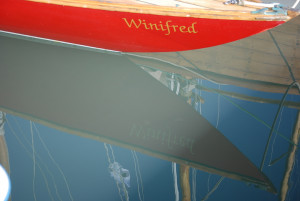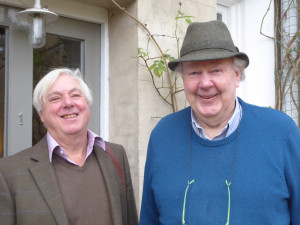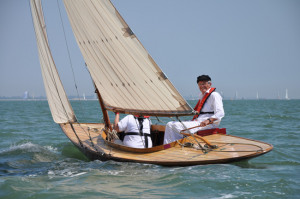It is very sad to report the death of Rees Martin, who died suddenly form a massive stroke on Saturday 20th February 2021, writes Dan Houston. Rees was well known to classic sailors as one of the founders of Cowes Classics Week. He was also a past secretary of the British International Six Metre Association and a major force in the Association of Yachting Historians, and its vice chair. A keen sailor since his youth Rees campaigned the Six Metre Bear in the mid noughties and also
commissioned Tino Rawnsley to build a replica of Herreshoff’s famous fin and bulb Wee Winn of 1892: Miss Winifred built in 1999. Latterly Rees owned and sailed the 1935 Tumlare Alert which he kept in Fowey.
Rees had an infectious enthusiasm for classic boating as well as boatbuilding and there will be many like me who will regret that he is not there for a chat, or an update or to gauge his opinion on some matter to do with sailing. I first met him covering a Six Metre event in the early summer of 2004. A month or so later he invited me to the Chelsea Arts Club – his favourite haunt, for a working lunch. Well, working might have been the intent, but Rees’s amazing sense of humour, his insight, his enthusiasm and intellectual curiosity ensured that we kept on ordering another bottle of the excellent white wine until both of us had lost count.
Luckily I was keeping notes because when we finally agreed that it was a good time to stop I remember being able to get out of the club and across the street and nothing more until I somehow made it home to Brighton.
Rees was six foot six inches tall in his bare feet and I have to imagine he had hollow legs where he could store that wine. He was always such fun and had such a sensible down to earth view of things. He was a very valuable member of and contributor to the classic sailing community. So fair winds Rees, as you cross the bar.
This is a copy of the article I wrote at the time (2004):
I’m sitting down to lunch at the Chelsea Arts Club with Rees Martin, the secretary of the British Six-Metre Association who is spearheading plans to bring all the International Metre Rule classes together at Cowes in 2007. Rees, a tall, at six foot six, affable New Zealander, is musing about the possibility of getting the 8-Metre people to re-schedule their Worlds’ event from the Clyde that summer, to take part in the planned jamboree that will mark the centenary of the first races under the International Rule.
The impetus for the event, as reported last month, has come from the Sixes and already has Royal Yacht Squadron backing. But traditionally, while the crews of the Metre classes happily up-and-down graded from Sixes, Eights and Twelves, owners were less enthusiastic. I couldn’t get Rees to admit it but there has been some Olympian snobbery afoot, as often as not from the Sixes’ owners as from the other classes.
So, with plans still at the, ah, development stage, I’ve come to talk to Rees to get to know him, and to find out what owning a 6-Metre is like. Over a welcomingly cool gazpacho soup on a hot day in June Rees tells me he first came to Britain aged 21 on a six-month work visa, and stayed ever since. “I was born at Gisborne, Hawk’s Bay on the North East coast. Most people in New Zealand sail or have boats and I sailed a small plywood P-Class dinghy when I was young, but I wouldn’t say I took much interest in sailing.
I went to university at Christchurch and became a maths teacher before coming to the UK and staying for a couple of years. Later I was touring Europe with my then future wife Jill and in Copenhagen we joined a three masted, 100ft (29M) 1918 topsail schooner, the Harold, which was being brought back to Hull, to be converted for charter in the Med. None of us really knew how to sail the boat and none of them could speak English. To my amazement I discovered that I had the most experience. She wasn’t that easy to handle; even the Hull pilot put the bowsprit through the railings of a bridge. It was a fun time. We ended up in Jersey where we were made temporary members of the Yacht Club in St Helier. But that ended when some of our crew, who were climbers, challenged the locals to climb the 30ft (9m) harbour wall, at Low Water which was at three o’clock on the morning. Everyone fell off! It was a good party but later, after half a dozen of us caked in mud walked to the showers the next morning, past the committee members in a meeting, our temporary memberships were withdrawn! I think that schooner is still around, maybe on the east coast of America.”
Rees got the bug of sailing and says that all his life he’s ended up buying a dinghy after any time spent off the water. With his new ‘Able Bodied’ credentials he was promptly signed onto a Greek, Panama-registered clay boat working out of Fowey and fell in love with the Cornish port. “I loved my time at sea, especially the four ’til eight morning watch,” he says. “But I needed a respectable job and so I joined a shipping company and forwarding agents dealing in antiques and art. We were shipping out containerfuls in the early 1970s.
It was a consortium with American partners, and I ended up working for a spell in Chicago working with the famous Mafia boss Tony Fernandez. Again running the shipping side of things. He lent me his car once and I pushed every button on this thing and ended up broken down on the freeway. When the police came, they recognised the car, and I got a special escort back to town!”
Rees got out before things went bad; Fernandez was later murdered by his own sons: “I don’t think I’d be alive now if I’d stayed there much longer – even to be associated with him was dangerous. I returned as manager for the UK part of the business and then started on my own in 1975 dealing in fine arts. I got back into sailing and that year in 1975 I started sailing an Albacore, at Chichester Yacht Club, and later in 1978 I bought a Dart which is a great boat, fun but scary! They are fast but if they start to pitch-pole you know it and you can get it back that much easier than a Hobie Cat.”
In 1980 he co-founded Momart, arranging shipping, exhibitions and storage of fine art, leaving to freelance in 1997.
He returned to Fowey, bought a house there and in 1999 met Richard Bond who had just finished restoring the James McGruer-designed Caprice, considered by Tim Street, and others as the most beautiful Six ever built. “Over a long lunch Richard and I discussed what boat I should have, and I ended up having Miss Winifred built, along the lines of Herreshoff’s famous fin and bulb Wee Winn of 1892.
“That process, with Tino Rawnsley building the boat, took about 18 months and I already thought that at 23ft 10in (7m) she was a bit small for me, I’m 6ft 6in (2m). Chris Evans and I had been using Kirlo at Fowey that summer and so he and I decided to buy the Six Metre Bear.
“Bear used to be owned by a Swede who owned Bear Shipping. This is now my fourth season with her, we bought her for £26,000 in 2000 and I bought Chris out a couple of years later as he had heavy business commitments. We have raced regularly and now we are winning. And it’s completely by accident that we have ended up with a boat to beat!
“The Metre class is filled with eccentrics the same as the art world. And some are incredibly flamboyant in their spending. And the perception of the Metre classes is so far removed from practicable sailing, or racing, that some find it impossible to relate to. We’re working to change that. My main argument about the whole thing is that we should be taking some of the elitism out of it. When I go down to Fowey (for the British Championships) I will take 12 sails with me which I will sell for £400 each. They’re good sails and when you are talking about young families building their boat up then I think that’s a brilliant thing. That’s how you keep the thing going.
“I’d say that sixty per cent of 6-M people are people who have jobs to hold down and it’s difficult to campaign a boat all the time like that. I think it’s cost me the best part of £1,000 to race in Lymington and it’ll cost a bit more to take part in the British Open Six-Metre Championships in June. But some crews split the cost of transport and accommodation between themselves and that makes it easier.
“The classics and the moderns are now starting to get very close. They are using contemporary products like rigging and sails; there is no restriction in the sail quality at all on the 6-Ms in the UK. Finvola (Wm Fife 1925) is a period boat, through and through, and that is why she is slower in the fleet. But Richard Bond ended up rebuilding Caprice to strengthen her to take a contemporary rig. And Thistle, Tom Richardson’s boat, is a good hard-weather boat, but she’s not so good in lighter winds. It’s true to say they can’t really compete to windward but there’s enough of an overlap to make the whole thing competitive, and so I don’t think there is a need to handicap.
“There are differences: moderns do get up to boat speed quicker but then the classics can do better in a choppy sea – they just seem to cut right through it. On the Friday of racing in Lymington Nancy (the then newly-restored 1932 Olin Stephens Six co-owned by Bill Green) beat us in two races. We have short races so that tactics and teamwork have a chance to affect the outcome as much as design. So on meets like the one in June we had four or five races in a day. It’s quite tiring because it’s very full on and there’s not much time to relax. But we’rea ll still able to have a good time and catch up in the bar afterwards.
“It’s amazing that you can have boats from 1929 racing with boats from 1989 and still have a close match. But that’s the whole essence of the International Rule. It has kept the design remarkably tight, while allowing things to evolve naturally.
“A few years ago people thought you would have to spend £100,000 to get a winning Six-Metre, and that’s a lot of money even now. But we spent £26K on Bear and I am in the World Championships. OK I may not win but it’s for the joy of sailing her against her sisters.”
Main photo (©DMH) shows Rees at the helm of Bear





